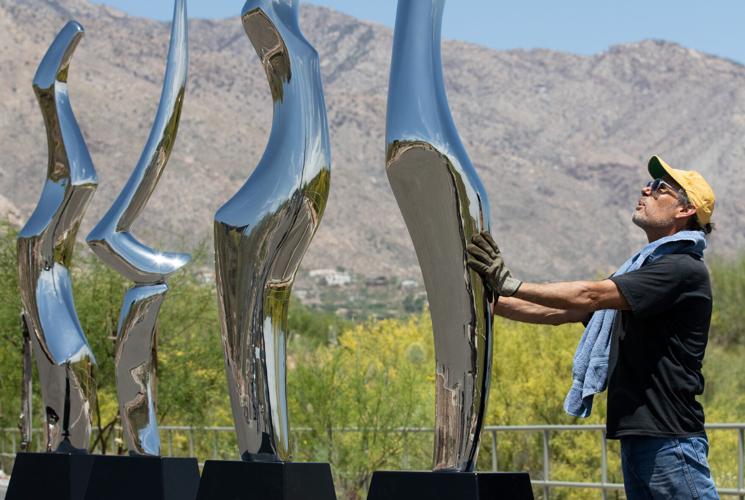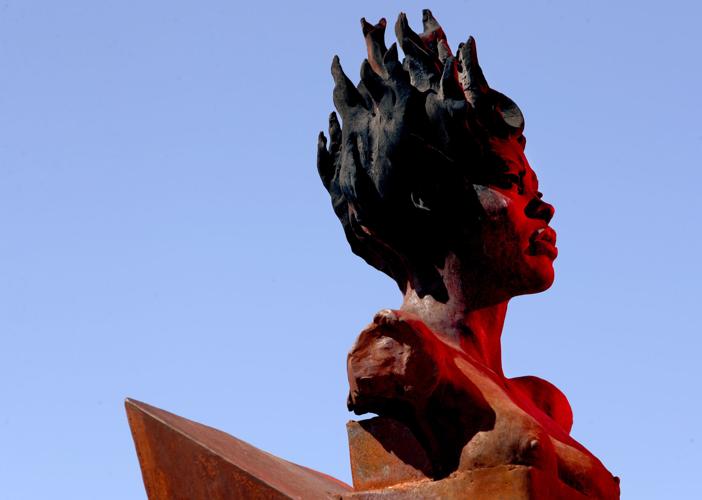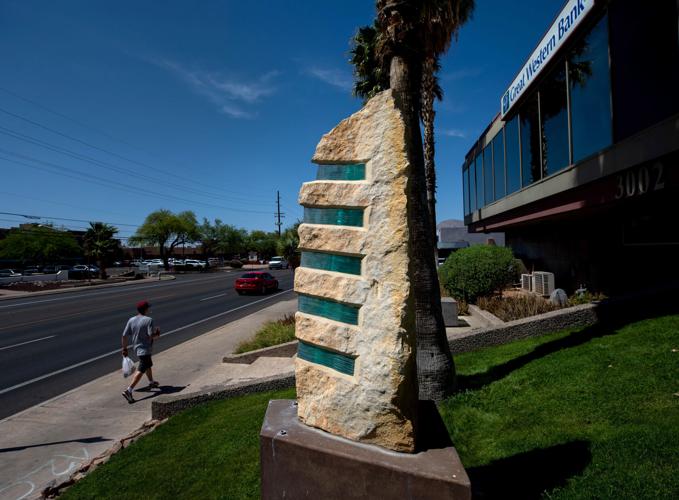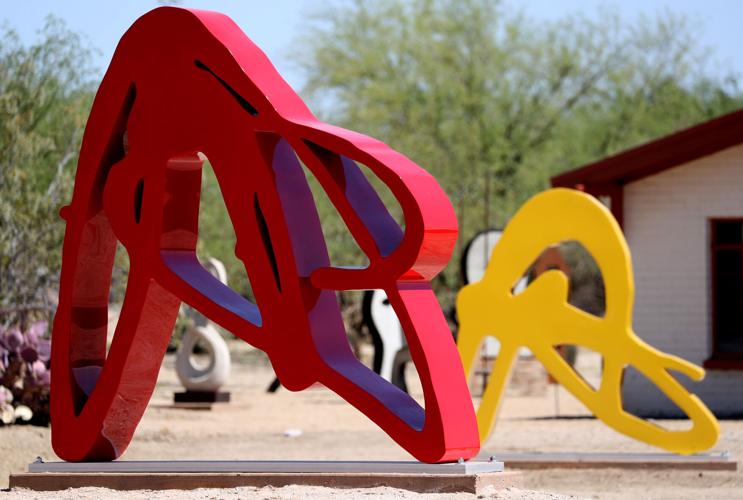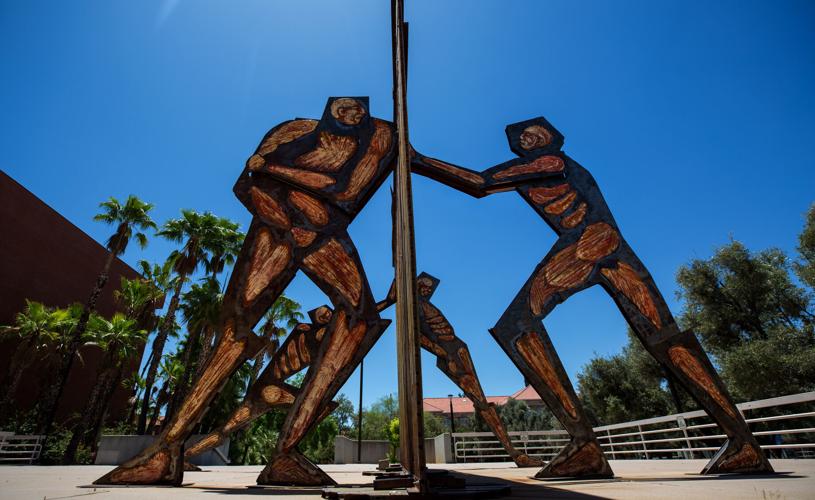Tucson enjoys a good mural. We do.
Whether it is humpback whales floating along a Southwestern skyline, black-and-white skeletons in cowboy attire, or faces filled with wonder painted in hypnotic purples, yellows and aqua blues, they brighten our day and are a welcome addition to walls across the city.
We like them. We love them. We want more of them.
But sometimes, we crave something a little more … three-dimensional.
While they don’t share the same level of celebrity as their mural counterparts, Tucson’s sculpture game is strong, and works can be found all over the city.
Shape your weekend plans by finding some local sculptures through these options.
Finding your way
Drive down any major thoroughfare in the Tucson area and you are bound to bump into some form of public art.
If you are actively seeking out pieces, there are several websites to help you on your journey.
The Pima County website has a detailed map where you can find information on every piece of art, more than four dozen in all, along all 131 miles of the Chuck Huckelberry Loop at tucne.ws/1hll.

The "batty biker" sculpture, depicting a bat riding a bicycle, is perched atop a pole along The Loop trail at the Broadway bridge over Pantano Wash.
The site even has a separate map to show the works that are clustered around the downtown section of the network of shared-use paths that encircle the city. You can find a PDF version of that map on the county’s main Loop page at tucne.ws/1hlm.
For an overview of the roughly 40 outdoor sculptures on the University of Arizona campus, the University of Arizona Museum of Art has you covered with an online map at artmuseum.arizona.edu/collections/public-art.
Perhaps the most comprehensive resource for where to find public art in Tucson is the interactive map available on the Arts Foundation for Tucson and Southern Arizona website at artsfoundtucson.org/arts/public-art/.
The arts agency, responsible for coordinating the teams that create and place public works of art around the city and county, has more than 200 locations marked on a Google Maps template. Click on a marker to find out the name of the piece, who created it, when it was commissioned, and even how much it cost.
“It is part of our stewardship as the Arts Foundation to make sure that the public has access to these beautiful works,” said Adriana Gallego, executive director of the foundation.
Gallego said the foundation is currently managing 30-40 active public art projects. She said the city’s murals, sculptures and other works of art were popular during the COVID-19 pandemic.
“Because of the intensity of the closures, taking precautions, safety measures and social distancing, there was a rise in interest,” she said. “People were looking for activities to do with their families that were safe.”
Gallego said the public should expect to see an overhaul of the Arts Foundation website in the coming months with an updated map and more interactive features.

“Goddess of Fire,” a steel piece that also incorporates fire, is by Alex Herveri and is part of the Rough Terrain show on the east end of Brandi Fenton Memorial Park.
Park within a park
It’s hard not to notice the larger-than-life works when driving by SculptureTucson’s “Rough Terrain” exhibition, along the west end of Brandi Fenton Memorial Park.
They greet drivers rounding the curve before East River Road turns into North Alvernon Way, fantastical figures made of steel, granite, aluminum and wood.
A bucking donkey celebrates freedom from its cart in Pat Frederick’s “Kicking off the Traces” while Curt Brill’s “Seated Diana,” a bronze on granite female figure with a steel base contemplates life to the hum of nearby traffic.
More than 20 sculptures make up “Rough Terrain,” named in part because of the dirt lot that the exhibition sits upon.
“It is not happening on a manicured lawn,” said Steve Kimble, one of SculptureTucson’s founding members. “That is not the Arizona way.”

Two pieces by Rotraut Klein-Moquay, without titles, are part of the Rough Terrain show at Brandi Fenton Memorial Park.
The sculpture park, right outside of SculptureTucson’s offices in the former home of Tucson artist Howard Post, offers an alternative to the 5-year-old nonprofit’s annual sculpture festival, which had to be canceled in 2020 and again this year because of the COVID-19 pandemic.
“Our first sculpture show was the largest show in the state of Arizona,” Kimble said. “The second year was even bigger. Things were going gangbusters, then COVID hit.”
The lot surrounding the Post House offered ample space and opportunity for regular sculpture exhibitions.
“There are artists in this town with lots of great sculpture that they haven’t placed anywhere,” Kimble said. “We said, ‘Let’s not have them in their backyards. Let’s have them out there for people to see.’”
The sculpture park is free and open to the public, noon-5 p.m. Wednesdays-Saturdays and will regularly rotate exhibits.
Most of the participating artists are local and all of the pieces are for sale.
Kimble said the hope is that local business owners might take interest in a sculpture or two at the sculpture park and have them installed on their own properties as part of SculptureTucson’s Sculpture on the Street program.

SculptureTucson has installed several pieces around town as part of its Sculpture on the Street program, including this limestone-and-glass piece dubbed “Southwest Marker” by artist Otto Rigan. It sits in front of the Great Western Bank on North Campbell Avenue.
SculptureTucson has already installed several pieces around town as part of the program, including a limestone-and-glass piece dubbed “Southwest Marker” by artist Otto Rigan, which sits in front of the Great Western Bank on North Campbell Avenue.
Kimble said businesses can look at the sculptures as identifiers for their properties.
“In Tucson, everyone knows the dinosaur McDonald’s, or the big Paul Bunyan guy,” he said. “A big beautiful sculpture in front of your business could be a great landmark. It is not just beautifying Tucson. It is bringing attention to your business, too. It is a win-win.”
The park, operated by SculptureTucson, currently has 22 large-scale works on display created by mostly local artists. Read more about it at tucne.ws/1hmq Video by the Gerald M. Gay/Arizona Daily Star
In December, the sculpture park will host a show of world renowned visual artist Rotraut Klein-Moquay, 82, whose works have been on display from San Francisco to Paris.
“Rough Terrain” is currently showing two of her pieces.
“It is going to be an amazing show,” Kimble said. “People will come from all around to see it.”
Visit sculpturetucson.org for more information.
Pop-up shows
In May 2020, while much of the city and the world sat hunkered in their homes, streaming endless hours of Netflix, YouTube and Amazon Prime, the folks at the Hacienda del Sol Guest Ranch Resort were offering a reprieve from lockdown.
For nearly a month, the historic property held a pop-up drive-thru sculpture show in one of its parking lots, featuring works from 19 local artists, including big names like Barbara Grygutis and Steven Derks.
The exhibition was a hit, said Jeff Timan, a partner at Hacienda del Sol.
“We had hundreds of cars come through,” Timan said. “The parking lot was never empty.”

Sculptor Mark A. Wallis places one of four polished stainless steel pieces that make up “Desert Spirits,” on display at the drive-thru pop-up sculpture exhibit in the parking lot of Hacienda del Sol Resort.
The resort had such a positive response that it has recruited another 18 artists to participate this year. The second annual drive-thru sculpture show started last weekend and runs through June 13.
The exhibition, being held in the same parking lot on the resort grounds, will feature some familiar faces in the Arizona art world, folks like Hector Ortega, John Benedict and Joy Fox McGrew, who works out of the Rancho Linda Vista artists community in Oracle.
“(Joy) is sort of uninhibited,” Timan said. “She is a sincere artist who puts it out there in ways you just have to admire.”
Like last year, visitors are encouraged to enjoy the pieces as they make their way through the lot. Unlike last year, people will be able to get out of their cars for a closer look at the sculptures if they see fit.
All of the pieces featured in the show will be for sale. The event will benefit several organizations, including SculptureTucson, the Southern Arizona Arts and Cultural Alliance and the Tucson Jewish Community Center sculpture garden.
Timan said several of the pieces sold at last year’s pop-up show.
“We are trying to make a market for these folks,” Timan said. “Most artists are not very good marketers of their work. They tend to be more timid socially as far as sales and the commercial aspects of art.”
Timan said this may be the last time Hacienda del Sol holds a pop-up sculpture show. The parking lot in which the show is set is on a side of the resort that has been under construction for the last year, and construction is just about finished.
“I’d like to see it done in other places,” Timan said. “There is opportunity there. Shopping centers, malls that are having issues now, this might be perfect for them.”
The exhibit is open from 9 a.m. to 7 p.m. daily and admission is free. Just roll up to the resort at 5501 N. Hacienda del Sol Road and look for the signs. Visit facebook.com/haciendadelsolaz for more information.

"Border Dynamics," created by Alberto Morackis and Guadalupe Serrano, is on the University of Arizona campus.


